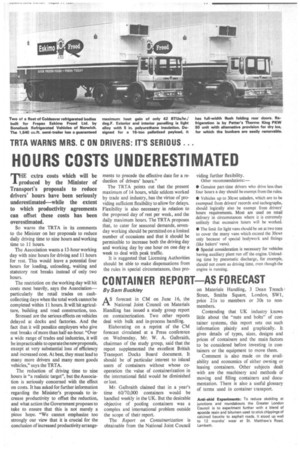HOURS COSTS UNDERESTIMATED
Page 19

If you've noticed an error in this article please click here to report it so we can fix it.
extra costs which will be produced by the Minister of Transport's proposals to reduce drivers' hours have been seriously underestimated—while the extent to which productivity agreements can offset these costs has been overestimated.
So warns the TRTA in its comments to the Minister on her proposals to reduce daily driving time to nine hours and working time to 11 hours.
The Association wants a 13-hour working day with nine hours for driving and 11 hours for rest. This would leave a potential four hours for loading, unloading, waiting and statutory rest breaks instead of only two hours.
The restriction on the working day will hit costs most heavily, says the Association— particularly the retail trades on cashcollecting days when the total work cannot be completed within 11 hours. It will hit agriculture, building and road construction, too.
Stressed are the serious effects on vehicles delayed at docks and factories. And the fact that it will penalize employers who give rest breaks of more than half-an-hour. "Over a wide range of trades and industries, it will be impracticable to operatethe newproposals, except at very substantial loss of efficiency and increased cost. At best, they must lead to many more drivers and many more goods vehicles," says the TRTA.
The reduction of driving time to nine hours is "a realistic target", but the Association is seriously concerned with the effect on costs. It has asked for further information regarding the Minister's proposals to increase productivity to offset the reduction, and what action the Government proposes to take to ensure that this is not merely a pious hope. "We cannot emphasize too strongly our view that it is crucial for the conclusion of increased productivity arrange
ments to precede the effective date for a reduction of drivers' hours."
The TRTA points out that the present maximum of 14 hours, while seldom worked by trade and industry, has the virtue of providing sufficient flexibility to allow for delays. Flexibility is also necessary in relation to the proposed day of rest per week, and the daily maximum hours. The TRTA proposes that, to cater for seasonal demands, sevenday working should be permitted on a limited number of occasions and that it should be permissible to increase both the driving day and working day by one hour on one day a week to deal with peak traffic.
It is suggested that Licensing Authorities should be able to make dispensations from the rules in special circumstances, thus pro viding further flexibility. Other recommendations:—
• Genuine part-time drivers who drive less than four hours a day should be exempt from the rules.
• Vehicles up to 30cwt unladen, which are to be exempted from drivers' records and tachographs, should logically also be exempt from drivers' hours requirements. Most are used on retail delivery in circumstances where it is extremely unlikely that excessive hours will be worked.
• The limit for light vans should be set at two tons to cover the many vans which exceed the 30cwt only because of special bodywork and fittings (like bakers' vans).
• Special consideration is necessary for vehicles having auxiliary plant run off the engine. Unloading time by pneumatic discharge, for example, should not count as driving time, even though the engine is running.












































































































